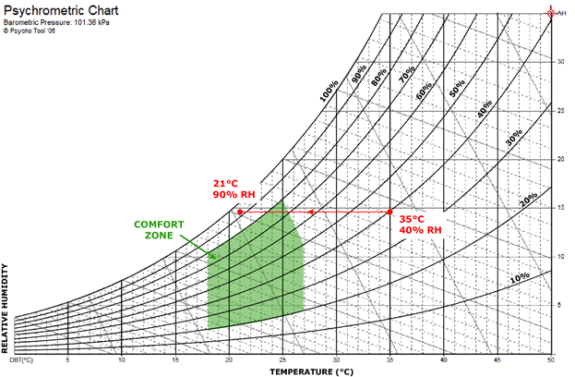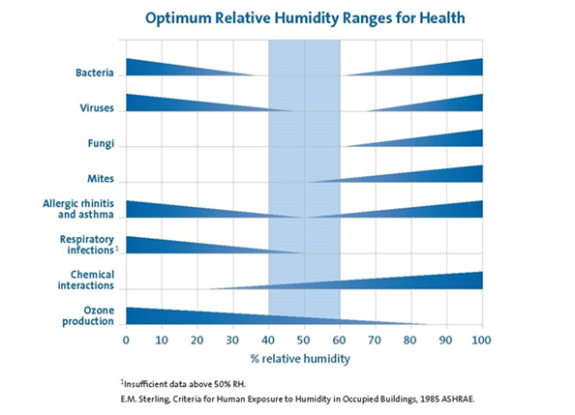In Vancouver, humidity is usually something you try to avoid in a building. High levels of humidity cause mold and condensation issues. When it is so often damp outdoors, it is easy to think that reducing humidity levels is what needs to be focused on, but it is not only high levels of humidity that should be prevented. Low humidity can have a huge impact on air quality and occupant health and comfort. It is known to support the spread of viruses and infection.
The recommended humidity levels for a healthy and comfortable indoor environment are between 30-60% relative humidity. The Canadian Standards Association (CSA) recommends that at a maximum, humidity levels should be between 20-70%. Relative humidity outside of these levels can cause physical discomfort, and above 70% can lead to physical damage to the building through condensation. Based on ASHRAE Standard 55 recommendations, at room temperature (21°C) RH levels should vary between about 30-75% (a dew-point temperature of occupied spaces no less than 2°C, with an upper-limit of 16.8°C at standard pressure).
What is relative humidity and how does it differ from absolute humidity?
Relative humidity (RH) is a measure of the air’s ability to hold evaporated water, expressed as a percentage. It depends on the ambient temperature and pressure of the air, as the capacity of air to hold moisture increases with temperature. Relative humidity can be thought of as a cup filled with water, where the size of the cup depends on the air temperature.
For example, an empty cup would be 0% relative humidity, and if the cup is half-full, we can say the relative humidity is 50%. If you continue filling up the cup, it will reach 100% RH when it is completely full, and the cup will begin to overflow. This is when condensation occurs.
Imagine that the temperature rises and cup gets twice as big, but the total amount of water remains the same. The cup is now only one-quarter full, or the RH is 25%, even though the total amount of moisture never changed.

At a certain elevation, the relationship between temperature, relative humidity, and absolute humidity (among other conditions) is more precisely understood with a psychrometric chart. Moving right along the chart indicates increased temperature, while moving straight up indicates an increase in absolute humidity. You can see that on a hot summer day, with 35 °C and 40% RH, simply cooling off outside air to a comfortable 21 °C will result in 90% RH indoors, which is clearly outside of the comfort zone.

So why use relative humidity, rather than absolute humidity, a measure of the actual amount of water in the air, independent of temperature? If you were to know only the amount of moisture in the air, while this is a useful metric in terms of how we “feel” moisture in the air, it tells nothing of the effects of humidity on evaporation. Since relative humidity tells us the moisture capacity of the air, you can have a better understanding of how moisture levels will affect evaporation (or how much space is left in the cup), and therefore how humidity can affect thermal comfort, air quality, and condensation in your home or office.
How does humidity impact your home/office?
As mentioned, high relative humidity can cause damage in your home or office. Relative humidity above 70% can cause mold, foggy windows, condensation, and warping of wooden objects such as furniture or window and door frames. When relative humidity and temperature are too high, occupants tend to feel more uncomfortable, as their ability to lose heat through perspiration is reduced. Additionally, high relative humidity has been known to increase the off-gassing of Volatile Organic Compounds (VOCs), which are dangerous chemicals (often carcinogenic) that are released from burning and off-gassing from a variety of consumer products. Similarly, a combination of high temperature and humidity has been found to exacerbate odour problems and decrease the acceptability of odours. Although the direct effect of humidity on odour is somewhat contested, it is known that temperature and humidity play a role in affecting one’s perception of odours. Studies have shown that cooler, drier air is generally perceived to be fresher.
On the other hand, relative humidity that is too low can increase static friction and interfere with electronics such as printers or computers. Like high humidity, wooden objects can become warped or split due to low levels of moisture in the air. For occupants, low relative humidity (and dryness in general) can cause discomfort in the eyes, throat, and lungs. Studies have found a correlation between decreasing humidity and respiratory illness and absenteeism in the winter. However, this is not the only impact that relative humidity can have on health.
Health impacts of humidity
As mentioned, low relative humidity can be uncomfortable, drying the skin and mucous surfaces of the body. This will result in dry, itchy, and chapped skin, a dry throat and nose, and dry eyes. Dry air can also increase frequencies of bloody noses, increase your risk of catching air-borne viruses or infections, and cause respiratory issues such as asthma, bronchitis and sinusitis by drying out your mucous membrane that is meant to protect your respiratory system and catch illnesses.
Relative humidity that is too high can cause fatigue, skin rashes due to an inability to release sweat, nose, eye, and throat irritation, and can worsen respiratory illnesses such as asthma or allergy symptoms. Along with a common feeling of being too warm in high humidity (due to the inability of the skin to release moisture), discomfort associated with high humidity is largely related to the actual feeling of moisture, and increased friction between skin and clothing, which can cause skin irritation.
Having healthy humidity levels are also very important in relation to infectious disease, bacteria, and virus transmission.
Relative Humidity, Viruses, and Bacteria
Both low and high levels of humidity can result in pathogenic risk. It is most commonly known that moisture supports bacterial and fungal life. Pathogens can enter through the occupants (through physical contact, shedding of skin, sneezing, coughing, etc.), and through incoming air (through a window, or even the ventilation system), and can remain on building surfaces for long periods of time. However, the proper management of indoor conditions can help prevent the reproduction and spread of pathogens.
Low relative humidity levels have been found to improve the lifetime of some viruses on hard surfaces. Airborne pathogens are also more likely to be transmitted with low levels of relative humidity. Infectious droplets from coughing and sneezing are transmitted to others by being suspended in the air. At a low humidity, water will quickly evaporate from the droplets, making them lighter and therefore easier to remain in suspension. If the relative humidity is higher, this evaporation will not happen as quickly, and the droplets are more likely to fall to the ground instead of being inhaled by another host. Therefore, to reduce the risk of infection, it is suggested that relative humidity should be maintained above 40%.
The ASHRAE Standard outlines that the virulence of a pathogen (harmfulness or severity) and its ability to survive depends on factors such as relative humidity, temperature, oxygen, pollutants, ozone, and ultraviolet light. Therefore, the control of indoor conditions and the use of appropriate filtration/purification methods can have a great impact on maintaining a healthy indoor environment.
Humidity solutions
In the winter months, humidity levels can often drop as low as 25%. However, there are a variety of ways in which one can maintain healthy humidity levels indoors:
- Adding a humidifier/dehumidifier – the most obvious solution, and in the winter months a humidifier is often needed. But it is important to be mindful of additional energy consumption and the unnecessary production of emissions. Managing relative humidity can be accomplished in a variety of other ways, and it is important to properly understand the relationship between your indoor environment and outdoor conditions throughout the year. Speak to an HVAC consultant about solutions, as each building is unique.
- Altering your ventilation levels – increasing ventilation when it is hot outside will only help decrease humidity when it is also very dry. Therefore, it is important to ensure your building ventilation system is equipped with a dehumidifier if you live in a humid climate. It is also important to make sure that on a hot day, cracking open a window may do more harm than good; while a breeze may feel good, even if it does not feel very humid outside, the humidity from outdoor air cooling down (and increasing in relative humidity) could be causing increased discomfort. This can also have health impacts: the AHSRAE Standard warns that ventilation resulting in increased humidity can increase dust mite and allergen levels indoors (among other risks of too-high humidity).
- Making sure your office is not too crowded – according to the ASHRAE Standard and an increasing number of publications, the effects of office ergonomics has a great impact on indoor environmental quality. When offices are overstaffed or too crowded with furniture that interfere with air flow or prevent temperature and humidity regulation (such as cabinets, partitions, etc.), a deterioration of indoor conditions can result in less-than adequate comfort levels. Therefore, it is suggested that you have an understanding of the locations of fans, vents, and sensors in your office, to ensure mechanical systems can be used to their maximum potential.
| Humidity too high | Humidity too low | |
| Summer | Using a dehumidifier can remove humidity from the air. Make sure you do not have windows open, as this will cause moisture from outside to enter. | Allow some fresh air inside if it is dry, and/or only in the evening. Doing this in the evenings and overnight can also help flush out stale air with fresh, cooler air for a healthier and more comfortable indoor environment with no extra energy costs. |
| Winter | Allow some fresh air inside! If outdoor air is too cold, the use of a heat recovery ventilator (HRV) can be a great way to maximize fresh air in your home while saving energy on heating. | Use a humidifier, either in your ventilation system or in specific rooms. At a personal level, applying moisturizers, taking warm (not hot) showers, drinking lots of water and making sure you have adequate levels of omega-3 can help combat dryness. |
Air quality can be confusing, but we are here to help. If you have any questions or would like to better understand your indoor environment, do not hesitate to reach out.
Citations
- 2017 ASHRAE Handbook: Fundamentals
- WorkSafe BC, “Indoor Air Quality: A Guide for Building Owners, Managers, and Occupants”
- National weather service, https://www.weather.gov/lmk/humidity
- https://www.ccohs.ca/oshanswers/phys_agents/thermal_comfort.html
- https://toxtown.nlm.nih.gov/chemicals-and-contaminants/volatile-organic-compounds-vocs
- https://www.ncbi.nlm.nih.gov/pmc/articles/PMC1474709/pdf/envhper00436-0331.pdf
- https://health.clevelandclinic.org/can-best-combat-effects-dry-winter-air/
- https://molekule.science/what-is-relative-humidity/
Written by Zoe Le Hong
